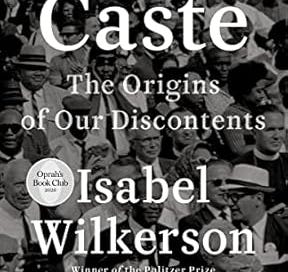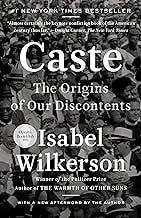Guerrilla Readers: April 2025
Some thoughts on CASTE, DEMOCRACY AWAKENING, JESUS & JOHN WAYNE
Last week, I introduced Caste with a brief readers’ guide. I hope that was helpful to you as you tackled what is often a brutal book, heavy with images we don’t want to look at or think about. (Brave you!—and even braver Wilkerson!)
This week, I’ve been thinking about the books we’ve read so far in this group (each one brave in its own way) and wanted to share those thoughts with you. Maybe they’ll help you see Wilkerson’s work in an even wider context. (I haven’t included Prequel because it tells a very different kind of story.)
I’m also opening comments to this post for those who have already read the book and have it on their minds. If that’s you, jump in.
Caste is insidious and therefore powerful because it is not hatred, it is not necessarily personal. It is the worn grooves of comforting routines and unthinking expectations, patterns of a social order that have been in place for so long
that it looks like the natural order of things.
—Isabel Wilkerson, Caste
Three Books, One Crisis
The three books we are reading in this group—Isabel Wilkerson’s Caste, Heather Cox Richardson’s Democracy Awakening, and Kristin Kobes Du Mez’s Jesus and John Wayne—aren’t telling the same story, but they’re definitely talking to each other. Together, they help us understand how American life got so tangled up in hierarchy, backlash, and belief—and what it might take to move forward.
Each book looks at a different layer of the same big mess:
Caste shows us the invisible structure underneath the whole thing: how power and personal worth are assigned, often by race/caste, in ways we hardly notice—unless we’re among the marginalized.
Democracy Awakening maps how our democratic system has been pushed to the edge by decades of strategic power plays using cultural divisions (race/caste) as political tools.
Jesus and John Wayne zooms in on white evangelical masculinity and how it became deeply tied to politics, fear of the Other, and control of the marginalized.
What they all say, each in its own way: This didn’t happen overnight. What we’re living with may look like the “the way things just happen to happen.” But it’s really the result of long-standing systems doing what they were built to do.
They also all focus on backlash. Wilkerson writes about how dominant groups push back hard when they feel the grasp on power slipping. Richardson walks us through political movements—from the Goldwater-Nixon Southern Strategy to Trump’s MAGA—that were built on fear of loss of power and resentment of the Other. Du Mez shows how evangelical leaders doubled down on masculinity and control as a response to feminism, civil rights, immigration, and LGBTQ. Backlash isn’t random. It’s a strategy.
And each book lands in the same place: We’re at a turning point.
Wilkerson asks: Can we be a true and lasting democracy if the structures that organize caste/race/gender stay in place?
Richardson warns that democracy only works if individuals and groups step up to defend it.
Du Mez asks (not very optimistically) whether and how white national evangelicalism can pull away from its power structures.
They all ask us to pay attention. And to decide.
What They Notice in Common
There are a few big ideas that these books circle around again and again:
History matters.
Who tells it, who gets left out, and how it’s used to justify power. All three authors show that forgetting (or rewriting) the past is a powerful way to keep things unequal.
Whiteness isn’t just about race—it’s about power over the Other.
Wilkerson puts whiteness at the top of the caste system. Richardson shows how it’s been used politically to divide people. Du Mez explores how it gets wrapped in religion, masculinity, and American identity.
Fear is a tool.
Not a feeling—an actual strategy. And mostly, it’s fear of the Other: fear of losing political power or status to the Other, and fear of the Other’s bringing change. These books show how fear is used to build loyalty, enforce silence, and keep people from questioning the system.
Religion can lift up—or lock down.
All three authors touch on the role of faith traditions. Sometimes religion fuels justice and community. But it’s also been used to reinforce caste, nationalism, patriarchy, and white power.
And finally: The stories we tell ourselves really matter.
From the myth of American innocence and specialness (Richardson) and the notion of strong-man saviors (Du Mez) to the story from under and outside, these books all ask: What happens when we finally start telling the whole truth about who we are?
Same Conversation, Different Angles
Even though these books are all dealing with power, identity, and what’s going wrong in America, they each come into the conversation from a different direction.
Wilkerson, in Caste, is more personal and reflective—this is her story, as a member of a “lower caste.” She invites us to slow down and spend some serious time thinking about the deeper structures that shape how we see each other—and ourselves. Her book is full of metaphors and big-picture thinking. It’s the kind of book that lingers on the questions, “What have you inherited? Where did that put you in the social hierarchy? How has it shaped who you are and what you do?”
Richardson, in Democracy Awakening, sounds the alarm. She has a historian’s eye on the past, a journalist’s sense of urgency about the present, and a teacher’s need to make things clear. Her book is like a timeline showing how we got from “We the People” to where we are now. She’s asking readers to pay attention—and to act.
Du Mez, in Jesus and John Wayne, digs into the culture, especially how white evangelical Christianity shaped a certain kind of American strong man. Her tone is sharp and direct. Her method is that of a cultural detective pulling together the clues. Her tone is a preacher’s call to repent and take a different way. She’s asking, “What have we been told to believe? Who does that serve? and What are you going to do about it?”
So while they all care deeply about justice, truth, and the future of the country, each is speaking from a different place. Wilkerson says: Look inside at who you are. Richardson says: Question the facts. Du Mez says: Ask harder questions about what you believe.
Put them together, and you get a full, powerful picture of where we’ve been—and what we need to rethink.
Let’s Think About This
Here are a few things to think about as you read, keeping the other books in mind. Some of you have asked me to open the discussion earlier, so that readers can chime in if they’ve already finished the book. So I’ll do that with this post. Jump in whenever and as often as you have something to add to the conversation.
Where do you notice the structure?
Wilkerson talks about caste as as a hidden framework, like a building’s joists and rafters—always there, shaping our lives even when we don’t see it. Do you notice anything like that in your own world? In your workplace, school, neighborhood/community, church, social media?
What’s fear doing here?
All three books show how fear is used to keep people in line—politically, socially, even spiritually. Have you seen moments when fear was driving the conversation or shaping people’s choices? What was the fear protecting—or trying to stop?
What stories do we believe about ourselves?
Whether it’s the “land of opportunity,” “a Christian nation,” or “we’re all equal under the law,” America is powered by story. Which ones did you grow up with? Are there any you’ve questioned lately, or even let go of?
Where do you fit in the big picture?
None of these books is about finger-pointing. They’re about awareness, about being (yes!) a guerrilla, about doing something to shape the outcome. So where do you see yourself in this bigger story about power, change, and identity? What feels like your role right now? What’s yours to do?
Congratulations (and thanks) for reading all the way to the end! I appreciate every single one of you and thank you for being part of this group of brave readers. I’ll be back on Monday with my usual LifeScapes post. See you then!






I am partway into Caste and I am amazed at how this book seems to explain the others. The idea behind caste systems is the fundamental belief that some people are better than others. This is the underpinning of all the other problems: racism, patriarchy, Christian nationalism, mistreatment of queer folks, all of it. Wow. I am learning so much. Thanks for suggesting these. My daughter is a librarian and she says this book is flying off the shelves. And that’s in a deep red state. That gives me hope.
We read Caste in our book study group awhile back - very powerful book. I find it interesting that people feel the pie never grows - if I don't grab my slice, I lose. But the pie keeps expanding. I am also struck by the current efforts to 'whitewash' history. It is as if admitting mistakes is a bad thing. Helen Keller: "Character cannot be developed in ease and quiet. Only through experience of trial and suffering can the soul be strengthened, ambition inspired and success achieved...All the world is full of suffering. It is also full of overcoming." I have experienced growth when I admit my mistakes and learn from them, not hide away pretending all is good. Striving to find that more perfect union is a good thing. Erasing history makes everyone a lot dumber and keeps us from learning and growing. Thanks for all you are doing in shepherding this discussion.